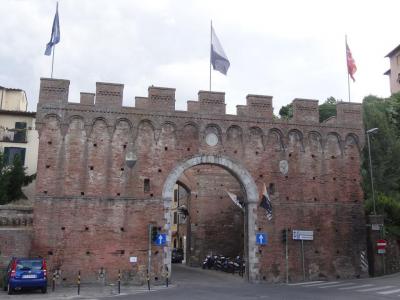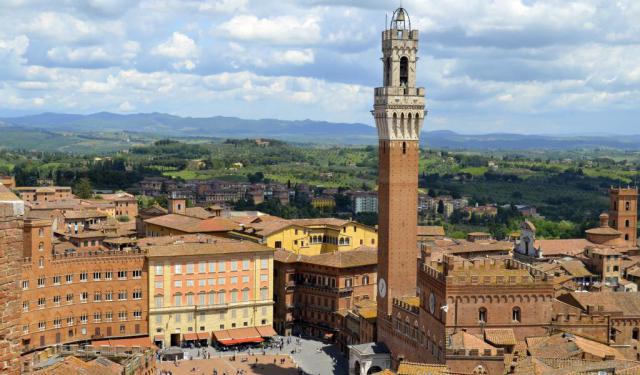Porta Ovile (Ovile Gate), Siena
Ovile Gate (Porta Ovile) is a historic city gate located in Siena, notable for its age, architectural features, and cultural significance within the city's medieval walls. Dating back to its first mention in 1220, this gate is strategically positioned between Vallerozzi and Simone Martini Streets (Via di Vallerozzi and Via Simone Martini). Its construction was initially completed around 1230, making it one of the oldest parts of the Sienese fortifications.
Significant for its robust and enduring design, Ovile Gate was involved in the defensive and urban developments of Siena through the Middle Ages. In 1251, it was fortified as a precaution against potential attacks from Florence, reflecting its importance in the city's defense strategy. Historical records from the Biccherna of 1250 refer to it as the "Gate of the Flock" (Porta del Gregge), indicating its role in local commerce and community life.
One of the most striking features of the Ovile Gate depicts the Madonna and Child, alongside Saints Ansano, Bernardino, and Angels. This fresco, dating from the 14th century, is not only a religious symbol but also represents one of the oldest remaining frescoes on Siena’s ancient walls.
Over the centuries, the Ovile Gate has witnessed several significant events. It was temporarily sealed in 1554 during the siege of Siena and used tactically to enhance the city's defenses against external threats. Unfortunately, it suffered considerable damage during an earthquake in 1798 that impacted the entire Ovile district.
Today, the Ovile Gate stands as a testament to Siena's rich history and cultural heritage. It remains well-preserved and is easily accessible from the city center, close to many of Siena’s main attractions. Its historical significance and architectural beauty continue to draw both locals and tourists, making it a cherished landmark within the vibrant tapestry of Siena’s past and present.
Significant for its robust and enduring design, Ovile Gate was involved in the defensive and urban developments of Siena through the Middle Ages. In 1251, it was fortified as a precaution against potential attacks from Florence, reflecting its importance in the city's defense strategy. Historical records from the Biccherna of 1250 refer to it as the "Gate of the Flock" (Porta del Gregge), indicating its role in local commerce and community life.
One of the most striking features of the Ovile Gate depicts the Madonna and Child, alongside Saints Ansano, Bernardino, and Angels. This fresco, dating from the 14th century, is not only a religious symbol but also represents one of the oldest remaining frescoes on Siena’s ancient walls.
Over the centuries, the Ovile Gate has witnessed several significant events. It was temporarily sealed in 1554 during the siege of Siena and used tactically to enhance the city's defenses against external threats. Unfortunately, it suffered considerable damage during an earthquake in 1798 that impacted the entire Ovile district.
Today, the Ovile Gate stands as a testament to Siena's rich history and cultural heritage. It remains well-preserved and is easily accessible from the city center, close to many of Siena’s main attractions. Its historical significance and architectural beauty continue to draw both locals and tourists, making it a cherished landmark within the vibrant tapestry of Siena’s past and present.
Want to visit this sight? Check out these Self-Guided Walking Tours in Siena. Alternatively, you can download the mobile app "GPSmyCity: Walks in 1K+ Cities" from Apple App Store or Google Play Store. The app turns your mobile device to a personal tour guide and it works offline, so no data plan is needed when traveling abroad.
Porta Ovile (Ovile Gate) on Map
Sight Name: Porta Ovile (Ovile Gate)
Sight Location: Siena, Italy (See walking tours in Siena)
Sight Type: Attraction/Landmark
Guide(s) Containing This Sight:
Sight Location: Siena, Italy (See walking tours in Siena)
Sight Type: Attraction/Landmark
Guide(s) Containing This Sight:
Walking Tours in Siena, Italy
Create Your Own Walk in Siena
Creating your own self-guided walk in Siena is easy and fun. Choose the city attractions that you want to see and a walk route map will be created just for you. You can even set your hotel as the start point of the walk.
Medieval Siena Walking Tour
Siena is a beautiful medieval city whose Gothic-era identity, acquired between the 12th and 15th centuries, has been successfully preserved due to the centuries of political and economic irrelevance in the shadow of its grander neighbor Florence. Today's Siena is a cultural gold mine and ideal place to revel in medieval Italy.
No tour of Siena is complete without visiting its heart, the... view more
Tour Duration: 2 Hour(s)
Travel Distance: 3.5 Km or 2.2 Miles
No tour of Siena is complete without visiting its heart, the... view more
Tour Duration: 2 Hour(s)
Travel Distance: 3.5 Km or 2.2 Miles
Siena Old Town Walking Tour
Siena was originally settled by Etruscans of Italy and later settled by Romans, who emulated Etruscan culture and named the city Sena Julia. The Lombard Kings then developed the city. By the 12th century, Siena was self-governing.
Siena established the Council of Nine in 1270. This Council was responsible for a flourishing economy, a focus on art, and a building boom. In 1348, Siena was... view more
Tour Duration: 1 Hour(s)
Travel Distance: 1.1 Km or 0.7 Miles
Siena established the Council of Nine in 1270. This Council was responsible for a flourishing economy, a focus on art, and a building boom. In 1348, Siena was... view more
Tour Duration: 1 Hour(s)
Travel Distance: 1.1 Km or 0.7 Miles
Siena's Palaces Walking Tour
A leisurely stroll through downtown Siena – a designated UNESCO World Heritage Site, full of imperious castles, palaces and other historic buildings – promises an exciting day of discovery and a pleasant experience for architecture buffs.
While most Italian cities have a church on their main square, Siena's famous Piazza Del Campo gathers around the city hall, known as Palazzo Pubblico... view more
Tour Duration: 1 Hour(s)
Travel Distance: 0.7 Km or 0.4 Miles
While most Italian cities have a church on their main square, Siena's famous Piazza Del Campo gathers around the city hall, known as Palazzo Pubblico... view more
Tour Duration: 1 Hour(s)
Travel Distance: 0.7 Km or 0.4 Miles






